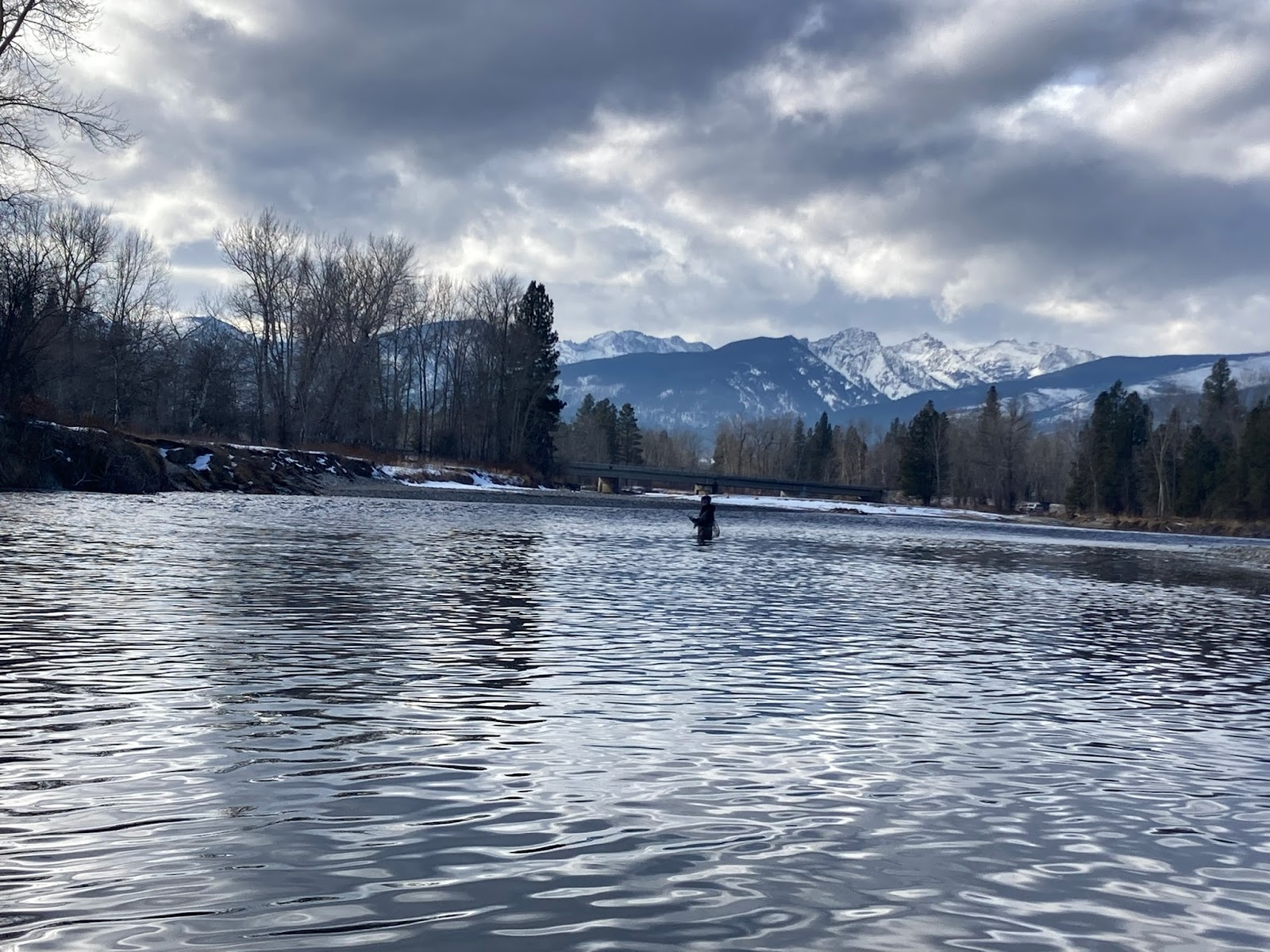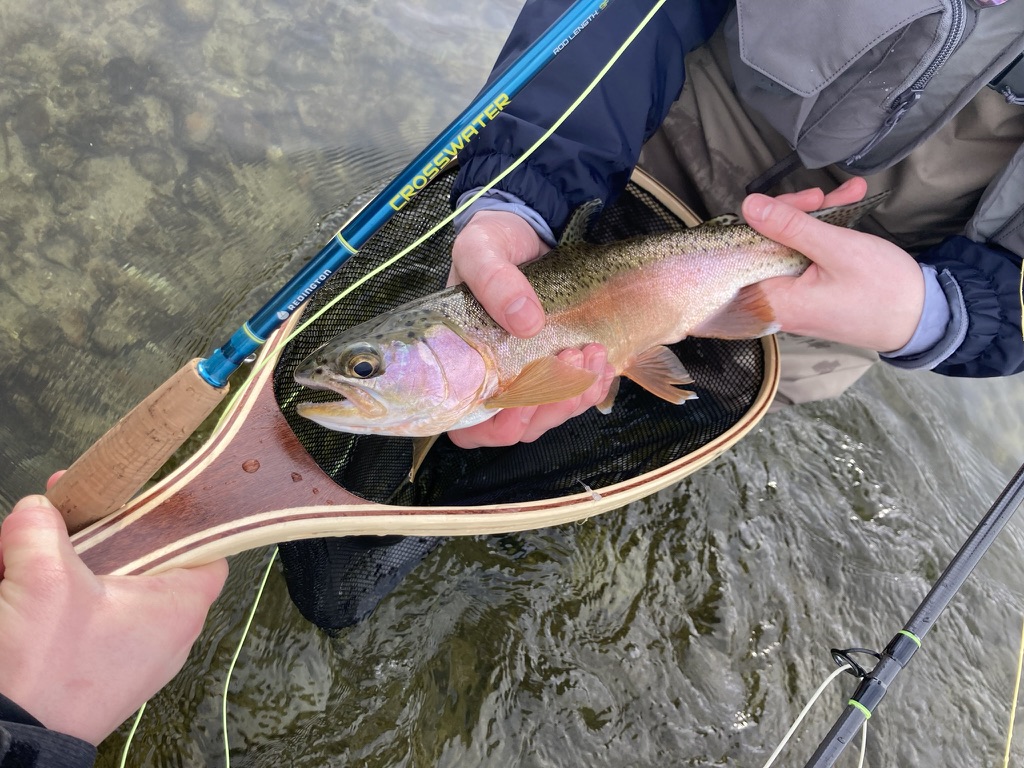Here is a short list of strategies I employ to increase my odds while fishing in the winter:
Top 5 Tips for Winter Fly Fishing
1. Staying Warm
2. Winter Flies
3. Low and Slow
4. Best Conditions
5. Tailwaters
Tip One: Staying Warm
This may seem like an obvious tip, but it is an extremely important consideration that greatly affects the type of day you are going to have on the water. Wintertime conditions quickly change with storm systems and wind, often dipping into the negatives. Staying warm is not only essential for your comfort, but it is imperative for your safety on these chilly days. Hypothermia is a serious risk and can be a real factor with an accidental slip into the water you are wading. There is an inherent danger to spending time outdoors in the winter, which is only amplified with time spent in the water. Taking the cold seriously and preparing for the worst is vital, and can be made simple by following a few thoughtful measures.
- Layer up! Multiple layers help to maintain body heat. Wear a beanie or other warm hat that covers ears. Moisture-wicking base layers and socks are key!
- Utilize hand warmers in pockets or gloves.
- Keep a dry cloth on hand. Fishing line delivers moisture to your hands, and freezing days require gear maintenance AKA chipping ice out of your rod eyelets. Use cloth to dry wet hands/arms.
- Bring a fire-starting device such as a lighter or small box of matches in a ziplock. This can come in handy if disaster strikes and you get soaked in the stream.
- Store a blanket and a towel in your car. Not only helpful to keep in your car for any winter disaster scenario, but is also a great tool to dry off and warm up after a day on the water.
- Keep moving! Don't be afraid to try multiple sections of water, or just take a short walk if you get cold. Moving helps elevate your bo
dy's core temperature, so feel free to stretch those legs.
Tip Two: Winter Flies
In the heart of winter, there are occasional, area-dependent flying insect hatches that some anglers like to target, but these hatches are few and far between. Let's just face it; winter is not a good time for dry flies. I probably lost a few readers there, but if you are excited to work deep holes with wet flies and streamers, winter is your time to shine! Worms, small midges, attractor patterns, and stonefly nymphs are all viable wet fly options, as well as baitfish and crayfish patterns for streamers. The following is a list of must-have nymph patterns for most winter fishing situations.
- Squirmy Wormy. Many fly anglers call this pattern sacrilege, but I call it effective. This pattern works all year, regardless of hatch or water condition. Pink or red are your best bet.
- Zebra Midge. One of the smallest nymph options, this little guy has a tendency to attract big fish. A superior tailwater pattern, this general chironomid imitation makes for the perfect dropper to imitate any small bug existing under the water's surface. Black or red are killers.
- Rainbow Warrior. Unlike its tropical name, this warrior works wonders in cold environments. Its colorful head makes way for a shiny body that proves itself irresistible to even the most stubborn trout.
- TJ Hooker. My personal favorite rubber legs pattern, the TJ Hooker is a fantastic lead fly to weigh down your set-up. This yummy pattern works year-round and has a tendency to attract larger trout.
Due to freezing water temperatures, trout tend to look for the warmest possible areas in the stream. This is typically in the slowest moving water and deep pockets, where they are not required to work very hard or use excessive energy. Trout are in an energy-conserving state during the winter, and are often so lackadaisical they will only move a few inches at a time for a drifting food source. Winter fish also show a tendency to congregate in larger groups together, all forced to hold in the same areas to avoid excessive energy use and vigor.
What does this information mean to the angler? It means that these fish are harder to locate, but if you can find one, you are likely to find others. Be on the lookout for deep pools and drop-offs, slower flows on the inside of bends, and long deep runs. Remember: low and slow water is key! If you start to catch trout, it is best to stay in place and feed them all the hits from your box. If you aren't catching anything, feel free to move on to the next target area.
Tip Four: Best Conditions
Fishing during the chilliest parts of the day can be a miserable experience. Cold winter conditions not only affect us, but they also affect trout populations immensely. Due to the low water temperatures, trout are nearly slowed down to a halt and only move as much as absolutely necessary during the coldest parts of the day. This means that during the heat of the day (warmest water temps), trout become much more active.
Fly fishing in the early morning and late evening may be the best tactic for other times of year, but during the winter months, the best time of day to fish is the afternoon. With a few hours of sun to warm up the water, this is your most productive window of opportunity to work the stream. It is helpful to keep in mind the previous day/night's conditions, as storm systems or sub-zero freezes will affect the following day's recovery rate as well. Ultimately, remember to sleep in, and get off the water as soon as it becomes too cold. Enjoy the afternoon sunshine and look for some fish!
Tip Five: Tailwaters
Are you getting the wintertime fishing blues because all of your local freestone rivers are frozen? Don't fret! Tailwater fisheries are here to save the day!
Dams create a consistent flow of water that fish can rely on and often do not reach the same freezing temperatures experienced by their freestone relatives. Trout patterns nearest to the dam remain the least affected (the further from the dam, the colder the water gets) and can be counted on in even the worst of conditions. Directly below dams, tailwater fisheries also have a lesser affected bug cycle, continuing to produce midges, shrimp, and scuds. Sometimes reaching a tailwater fishery requires a trip, but it is well worth the hassle to satisfy your irresistible fly fishing cravings.
Please note: Not all tailwaters stay unfrozen! My current residence in Wisconsin has two tailwater salmon fisheries nearby that both freeze solid during the winter. Be sure to perform your due diligence by researching your local fishery to determine if it is fishable during the winter.
Conclusion
"Just because it's winter, it doesn't mean fly fishing is over." You will hear this in many fly shops you visit, and sometimes they will even tell you it is one of their favorite seasons to fish. There are little to no crowds, the fish are still swimming around eating, and it can be a beautiful time of year to be outside. Winter is certainly one of the more challenging seasons to fish, but catching trout can be accomplished using sound methods with the right approach. You may be in for a surprise; winter fishing can lead to some impressive results!










No comments:
Post a Comment